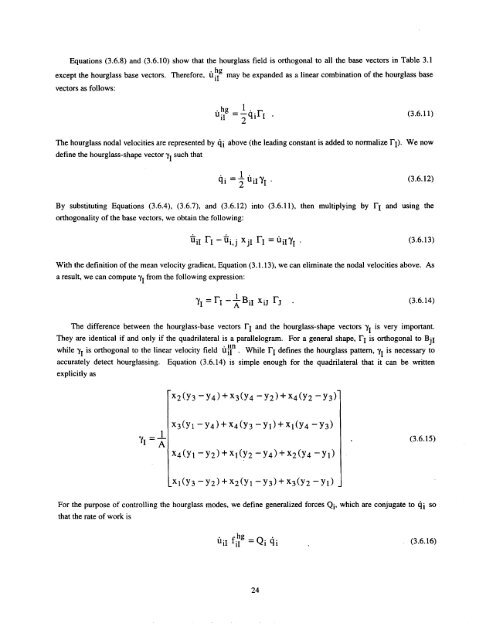II II II II II I - Waste Isolation Pilot Plant - U.S. Department of Energy
II II II II II I - Waste Isolation Pilot Plant - U.S. Department of Energy
II II II II II I - Waste Isolation Pilot Plant - U.S. Department of Energy
- No tags were found...
Create successful ePaper yourself
Turn your PDF publications into a flip-book with our unique Google optimized e-Paper software.
Equations (3.6.8) and (3.6.10) show that the hourglass field is orthogonal to all the base vectors in Table 3.1<br />
hg<br />
except the hourglass base vectors. Therefore, u il may be expanded as a linear combination <strong>of</strong> the hourglass base<br />
vectors as follows:<br />
(3.6.11)<br />
The hourglass nodal velocities are represented by ~i above (the leading constant is added to normalize rI). We now<br />
define the hourglass-shape<br />
vector yl such that<br />
qi ‘~uiI~l . (3.6.12)<br />
13y substituting Equations (3.6.4), (3.6.7), and (3.6.12) into (3.6.11), then multiplying by rI and using the<br />
orthogonality <strong>of</strong> the base vectors, we obtain the following:<br />
iiiI rI ‘iii,j XJI rI = uiI~l . (3.6.13)<br />
With the definition <strong>of</strong> the mean velocity gradient, Equation (3.1.13), we can eliminate the nodal velocities above. As<br />
a result, we can compute ‘yIfrom the following expression:<br />
YI=rI–~BiI xiJ rJ . (3.6.14)<br />
The difference between the hourglass-base vectors rI and the hourglass-shape vectors ‘yI is very important.<br />
They are identical if and only if the quadrilateral is a parallelogram. For a general shape, rI is orthogonal to BjI<br />
while yl is orthogonal to the linear velocity field u y. while rI defines the hourglass pattern, <strong>II</strong> is necessary to<br />
accurately detect hourglassing. Equation (3.6. 14) is simple enough for the quadrilateral that it can be written<br />
explicitly<br />
as<br />
‘2(Y3 ‘y4)+x3b’4 ‘Y2)+X4(Y2 ‘Y3)<br />
x3(yl–y4)+ x4(y3–yl) +xl(y4–y3)<br />
~1=*<br />
(3.6.15)<br />
x4(yl–y2) +xl(y2–y4) +x2(y4–yl)<br />
LX,(YS‘Y2)+XZ(Y, ‘Y3)+X3(Y2 ‘YI)<br />
For the purpose <strong>of</strong> controlling the hourglass modes, we define generalized forces Qi, which are conjugate to ~i so<br />
that the rate <strong>of</strong> work is<br />
‘g= Qiqi .<br />
U iI fi~ (3.6.16)<br />
24
















